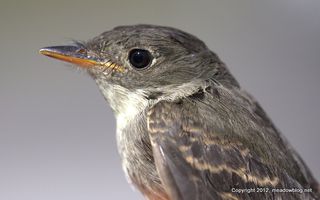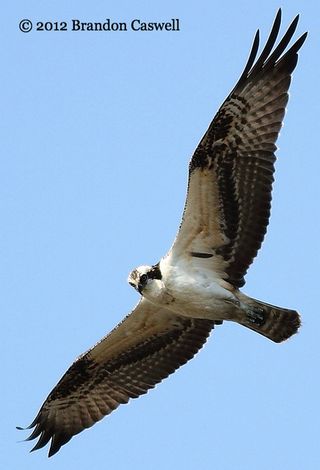After much deliberation and  consultation, the NJMC bird-banding team determined that this is an Eastern Wood pewee.
consultation, the NJMC bird-banding team determined that this is an Eastern Wood pewee.
More on Eastern Wood-Pewees here.

After much deliberation and  consultation, the NJMC bird-banding team determined that this is an Eastern Wood pewee.
consultation, the NJMC bird-banding team determined that this is an Eastern Wood pewee.
More on Eastern Wood-Pewees here.
Regarding the cormorant seen this past weekend with the hook through its mouth, Lauren Butcher of The Raptor Trust writes:
"This is a difficult situation — this young cormorant obviously needs help if possible, but as long as it can fly and swim, it will be nearly impossible to catch. Wild goose chases don't just apply to wild geese!
"In cases like this, the only opportunity to capture the bird may be (unfortunately) as it becomes more debilitated from infection or hunger.
"If you do have the opportunity to look for this cormorant again, you might go prepared with a deep, long-handled net (small holes in the mesh would be best so the bird doesn't get tangled), a beach towel or blanket, some thick work gloves, and a secure cardboard box with air holes, lined with a towel. (Actually, this is a good bird rescue kit to have for all sorts of situations.)"
The rest of her advice follows.
Ramon Gomez phoned to say he saw two Wood Ducks at the Kearny Marsh this afternoon (park at Gunnell Oval and head right on the trail), plus an American Coot nearby and White-crowned Sparrows on the trail itself…
(Thanks, Ramon!)

Elaine Raine saw this young Double-crested Cormorant over the weekend in DeKorte Park. If you look at the photo closely, you'll notice it has some sort of metal pin in its mouth — not a good situation.
If you see the cormorant and it can be safely caught, consult the following advice on how to deal with injured birds, courtesy of The Raptor Trust website, located here. (Thanks, Elaine!)
You can also contact the NJMC's Jim Wright, jim.wright [at] njmeadowlands.gov.
 The Hudson Reporter this week featured a neat little story and slide show about this Praying Mantis photographed by Mickey Raine, a friend of this blog.
The Hudson Reporter this week featured a neat little story and slide show about this Praying Mantis photographed by Mickey Raine, a friend of this blog.
The link to the slide show and story are here.
As you may recally, Mickey and his wife Elaine saved hundreds of Praying Mantis eggs at Mill Creek Marsh earlier this year. That post is here. (Thanks, Mickey and Elaine!)
"My wife and I went on the canoeing trip Saturday.
"  Tide was low and it was a totally different perspective of the Saw Mill Creek Wildlife Management Area from last last time (we went on the last one in June at high tide).
Tide was low and it was a totally different perspective of the Saw Mill Creek Wildlife Management Area from last last time (we went on the last one in June at high tide).
"We saw a lot of stuff back there. Notables were Yellow-crowned Night-Herons, Black-Crowned Night-Herons, Green-winged Teals and Ospreys hovering as they were hunting for fish.
"A couple shots from the outing are attached."
(Thanks, Brandon!)
That was our last canoe trip of 2012. Hope to see you next spring!
 Karen Zautyk of The Observer wrote a dandy story on "The Lost Bird Project" screening at DeKorte Park last week.
Karen Zautyk of The Observer wrote a dandy story on "The Lost Bird Project" screening at DeKorte Park last week.
Zautyk writes:
"In 1800, the Passenger Pigeon was considered 'the most abundant land bird on Earth.' An estimated 3 to 5 billion populated North America…
"A century later, they were all gone. All those billions…
"The extinction had been unthinkable, but it happened. A lesson to humankind — and yet to be learned by far too many people.
"Now, a new documentary, 'The Lost Bird Project,' seeks to teach us a bit more about the fragility of nature."
The link is here.